















Toyota Unveils 'Pod' Car |
|---|
 Topics: Toyota pod
Topics: Toyota pod
|
Michael Leland
Chicago
February 13, 2002
 Listen to Toyota Unveils 'Pod' Car - MP3 - 494KB - 4:00
Listen to Toyota Unveils 'Pod' Car - MP3 - 494KB - 4:00
Most car-owning Americans probably feel they could not live without their automobiles. Some might even go so far as to say they love their car, maybe even giving it a name. For this latter group, Japan's Toyota Motor Company has developed a new vehicle it says communicates with and even understands the driver.
It is called the "pod," which stands for Personalization on Demand. It is a concept vehicle developed jointly by Toyota and Sony Corp. The pod looks a little bit like the Volkswagen Beetle, but, according to Dave Hermance of Toyota's U.S. Technical Center, it does more than the average Beetle. "It has sensors built into the controller, which is a palm of your hand kind of system, that monitors the driver's pulse and perspiration rate and also has a voice-recognition system that monitors conversations going on in the vehicle," he said.
The information gathered by the car's monitors is used to adjust the car's interior climate, musical selections on the sound system, and even how fast or even whether the car moves forward. Don Esmond is Toyota's U.S. Division General Manager. "Sensing that the driver is in a hurry, it will try to relax the driver by soothing music, cool air and various warning displays," said Don Esmond. "If the driver conveys signs of "road rage," [anger] pod will slow to a stop, offering a time-out [break] for the driver."
The pod compares the driver's performance and style to that of a professional driver, and can stiffen or soften the vehicle's suspension depending on the driver's skill level.
Inside the car, one of the first things you notice is there are no foot pedals and no steering wheel. Dave Hermance says those have been replaced by a single controller that looks like a large joystick from a video game. "The joystick controller actually rolls down on the right side of the vehicle," he said. "You stick your right palm into it and accelerate by going forward, brake by coming back, left and right turn by [moving the] joystick. The younger generation will definitely feel right at home driving the vehicle. Old guys like me, it will be a bit of a transition."
Toyota says the pod can express up to ten emotions through its lighting and mechanical system. The car has lights embedded in its hood that change color along with the car's mood. Wash the car or refuel it and the pod's hood glows a bright orange. If the driver hits the brakes too hard, the pod glows an angry red.
The pod can also learn the driver's tastes in music, television or shopping through the use of something called a "mini-pod." That is a hand-held device that the driver can connect to his or her home computer, where it stores the owner's preferences among various shopping and entertainment choices. The mini-pod also acts as an electronic door-opener for the car, and ignition starter.
The pod is not for sale. It is a concept car, which allows Toyota to test out its various features to see whether they might be usable in cars that are in production. The Chairman of General Motors' North American Division, Bob Lutz, says automakers learn a lot from their concept vehicles. "To me, the value of a concept car is not that you potentially put it into production," said Bob Lutz. "It is to validate your in-house views on future design and taste directions and get to resonance back from the press and the viewers."
In the case of the pod, Toyota's Dave Hermance says it is all about seeing how much gadgetry people want in their cars. "We need to start exploring and getting reaction to things that are possible with the interaction of telematics - computerization - within the vehicle," he said. "We will see what the market [public] is interested in, and what it might not be interested in."
The pod made its debut at last year's Tokyo Auto Show. This is the first time it has been on display in the United States.
